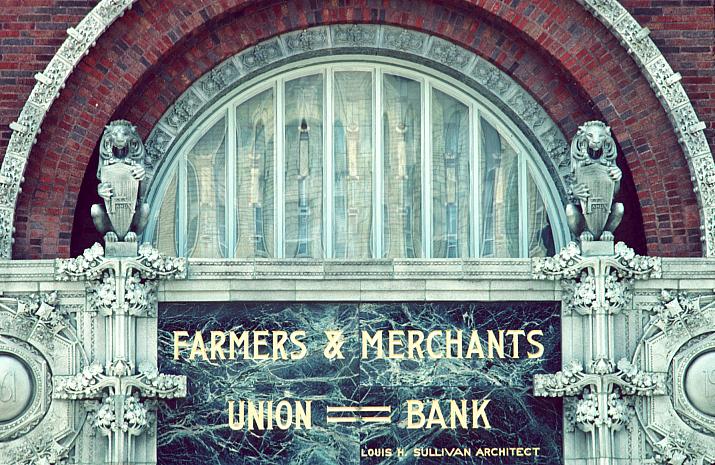
The Farmers and Merchants Union Bank in Columbus, Wisconsin, also known as Farmers' and Merchants' Union Bank, is the last of eight "jewel box" bank buildings designed by Louis Sullivan. It was next to last to be constructed and designed by Sullivan. It is located at the northwest corner of James Street and Broadway in Columbus. Sullivan used late 19th and early 20th Century American Movements architectural type. It is built of a soft shade of red brick, highlighted with touches of blue. Sullivan was very particular that the bricks be selected at random so as to give a casually shaded effect. The narrow horizontal lines echo the Prairie style that Frank Lloyd Wright-a student of Sullivan's-was later known for. The simple cube of the bank's exterior is elaborately ornamented in terracotta which is glazed in a pale green and mottled with specs of brown. Its most impressive feature is the decorated entry way. A series of archways recede to form a frame around the stained-glass windows, which lights the interior in shades of yellow, green and ruby red. Below the archway a marble lintel bears the name of the bank and its architect. Elaborately framed in the delicate geometric design and curling leaf tendrils that are Sullivan's trademark, are the dates 1861 and 1919. The year the bank was founded, 1861, and the year the building was built, 1919. Two lions stand guard above the lintel and at the center of the front and rear of the building are two identical eagles accompanied by the word "forward," the state motto. Along the side of the building facing Dickason Boulevard are a series of ornamented archways, which are buttressed at either end by square block pillars. Throughout the inside of the building are dark green marble countertops, accompanied by wrought iron teller cages and dark prairie style wood work. Sullivan's details are easily recognizable and can be seen in the terracotta drinking fountain, which greets visitors at the front door on a summer day. Even a small set of movable wrought iron steps are available for children so they can reach the teller window. In the corner of the lobby shines a beautiful lamp with a stained-glass shade, it was a token given to Mr. Wheeler by Sullivan, celebrating the completion of the building. It was announced as a National Historic Landmark in 1976.
No comments:
Post a Comment